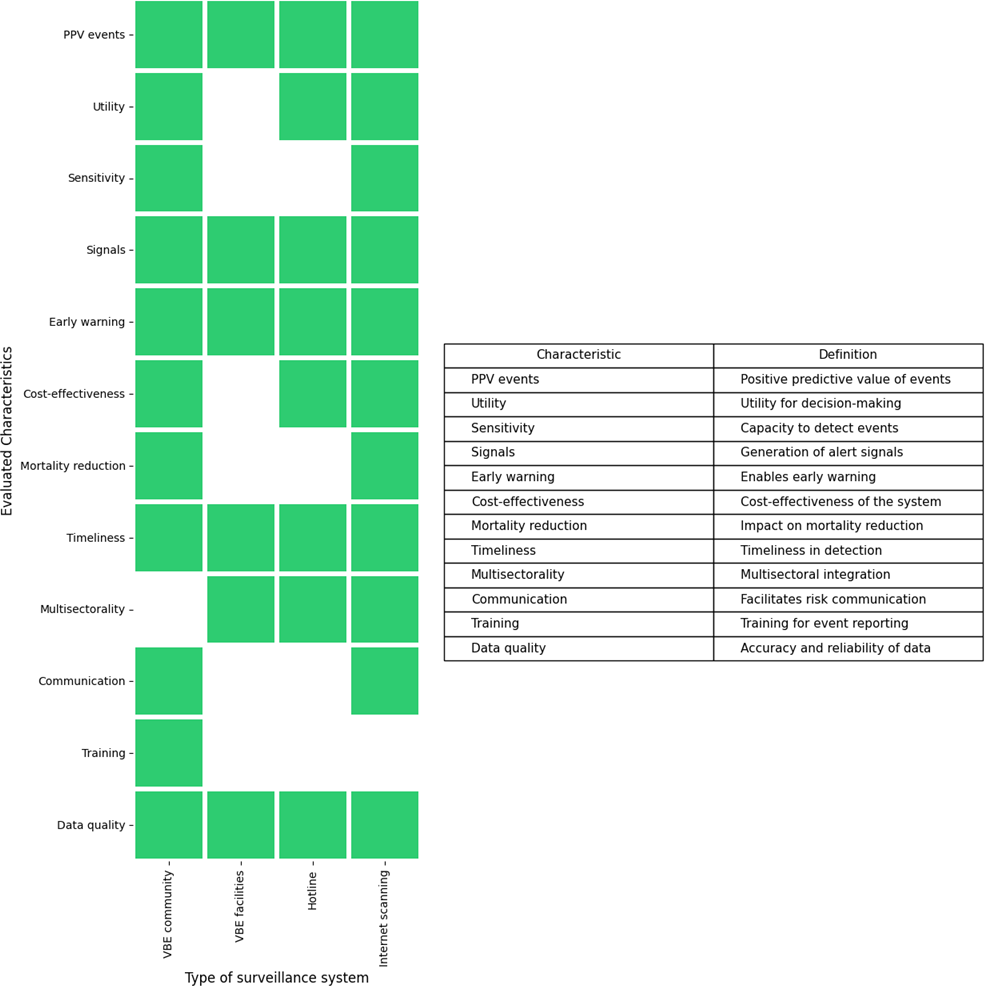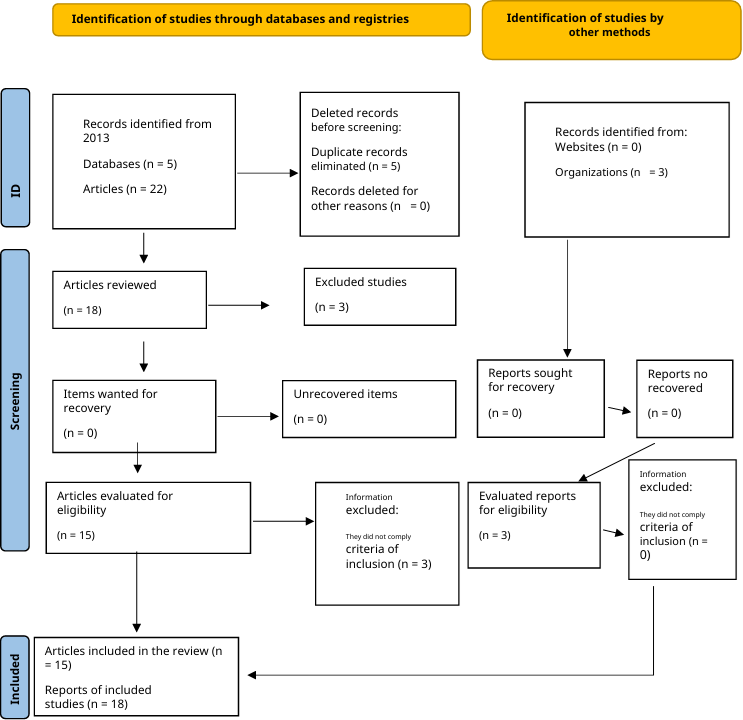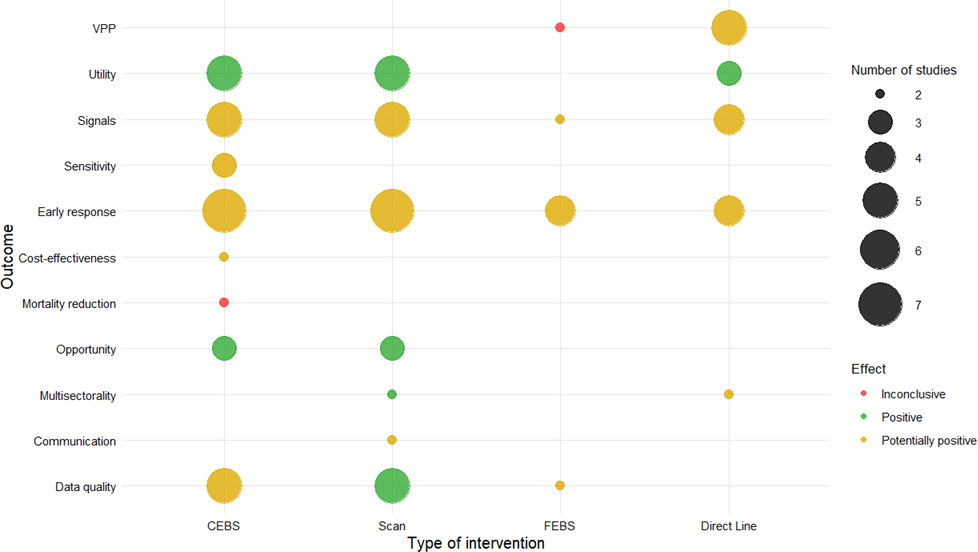Artículo de revisión
← vista completaPublicado el 19 de mayo de 2025 | http://doi.org/10.5867/medwave.2025.04.3031
Vigilancia basada en eventos en países de medianos y bajos ingresos: un mapa de evidencia
Event-based surveillance in middle- and low-income countries: An evidence map
Abstract
Event-based surveillance is an important strategy for the early detection of outbreaks of all types of diseases, especially in low- and middle-income countries. This research focuses on an evidence map, which systematizes and graphically represents the information gathered on the effectiveness of various interventions in these contexts. Key interventions include data quality, training, communication, multisectoral collaboration, timeliness, mortality and morbidity reduction, cost-effectiveness, early response to events, sensitivity, signals, and usefulness for real events. In this study, a review and evaluation of the literature was conducted on a total of 22 systematic reviews; 15 met the inclusion criteria, containing a total of 82 open-access primary articles. The quality of the evidence was assessed using the AMSTAR tool, identifying reviews with high, medium, and low reliability. The results show that event-based surveillance has been successfully implemented in countries such as the United States, Brazil, China, Australia, Canada, India, Japan, New Zealand, Taiwan, the Netherlands, the United Arab Emirates, and others. From the evidence gathered in these countries, it is clear that event-based surveillance improves early outbreak detection, alert response, and minimizes the spread of diseases. Further research and improvement of these strategies are needed for effective early detection and response to public health events.
Main messages
- Event-based surveillance is essential for early detection of outbreaks in low- and middle-income countries and complements traditional surveillance.
- This study highlights its relevance in resource-constrained settings and provides a detailed analysis of the various ways it can be implemented and its main achievements.
- Multisectoral integration and the use of digital technologies can strengthen event-based surveillance and health systems in low- and middle-income countries.
Introduction
Event-based surveillance is defined as the collection, monitoring, evaluation, and interpretation of information, mainly unstructured, about health events or occurrences that may pose a risk to human health. According to Jones et al. [1], it has five main steps: detection, triage, verification, risk assessment, and alert for action and response [2]. Event-based surveillance focuses on detecting situations that may indicate the presence of disease outbreaks, enabling a rapid and effective response to contain the spread of such diseases [3]. This strategy can be crucial in settings where health systems are fragile and resources are limited.
Unlike traditional surveillance systems, event-based surveillance leverages unstructured information, such as rumors or reports from various sources, including health professionals, the media, and non-governmental organizations. Its effectiveness stems from the speed with which it processes and responds to potential threats, including disease outbreaks, food contamination, or environmental risks, to minimize their impact [4].
In low- and middle-income countries (LMICs), event-based surveillance complements indicator-based surveillance, the routine surveillance model in most health systems in these countries, by covering a broader spectrum based mainly on multiple sources. These sources can be part of event-based surveillance, unlike indicator-based surveillance, which focuses solely on reports of health service provision. This allows event-based surveillance to be more effective in rapidly identifying outbreaks and other health risks that might have gone unnoticed or been detected late by indicator-based surveillance [5]. Other operational definitions, including that used by the Africa Centers for Disease Control and Prevention (Africa CDC), have expanded the definition beyond human health to a multisectoral perspective based on the One Health approach, which incorporates animal and environmental health [2,6].
On the other hand, in a technology-driven world, the ability to respond quickly to public health threats has become more crucial than ever [7]. The internet and digital tools have revolutionized the way we monitor and detect outbreaks, enabling event-based surveillance to collect real-time information and facilitate more agile responses. This advancement has improved surveillance systems in resource-constrained settings, offering new opportunities to mitigate global health risks [8].
In this context, the objective of this review is to map the evidence on the various approaches to event-based surveillance in low- and middle-income countries. It also aims to demonstrate how these approaches, when combined, can yield better results.
Methods
The research question, structured in the Participants, Interventions, Comparisons, Outcomes (PICO) format, was:
Is event-based surveillance more effective than other surveillance systems for the early detection of epidemic outbreaks in low- and middle-income countries?
This question guided the methodological process, defining the key components as follows:
-
Population (P): low- and middle-income countries.
-
Intervention (I): event-based surveillance, including community surveillance, hotlines, internet-based media scanning, and surveillance in health facilities.
-
Comparator (C): traditional indicator-based surveillance systems.
-
Outcomes: early outbreak detection, data quality, early response to events, reduction in mortality and morbidity, cost-effectiveness, sensitivity, signals, utility, and positive predictive value for real events.
To this end, a study was conducted based on a review of systematic reviews, a rigorous methodological approach that synthesizes evidence exclusively from previously published systematic reviews. This strategy was selected because of its ability to guarantee the robustness and quality of the information analyzed, thus ensuring the reliability of the results. The process included developing an evidence map, which is a structured method that systematizes and graphically presents data extracted from scientific studies, prioritizing systematic reviews related to the impact of various interventions on health outcomes [9]. This approach allowed us to not only identify the available evidence on the topic in question but also to detect knowledge gaps and priority needs for future research. In addition, the findings were organized and presented in a format that is accessible and understandable to end users, facilitating their practical application in decision-making [10]. The protocol for this review was registered in the Open Science Framework (OSF) under the following link:
Studies examining key interventions such as community surveillance, hotlines, internet-based media scanning, and surveillance in healthcare facilities were included. The selected articles had to report specific results related to early outbreak detection, data quality, response to events, and cost-effectiveness of interventions to ensure the rigor of the analysis. Priority was given to open-access publications in English or Spanish whose methodological quality was rated as high or moderate according to A Measurement Tool to Assess Systematic Reviews (AMSTAR). However, it is important to note that all relevant references identified during the literature search were considered in the analysis, regardless of their initial level of methodological quality. This was done to provide a comprehensive representation of the available evidence on the subject. These references are detailed in the data matrix (Table 1) in the supplementary material, where they are classified according to their level of confidence as assessed by AMSTAR. This approach provides a comprehensive view of the existing evidence, including both high-quality studies and those with methodological limitations. This facilitates the identification of knowledge gaps and priority areas for future research.
Studies with unclear methodologies or inadequate assessment of data quality were excluded, as were those that did not provide sufficient information on key event-based surveillance outcomes. Research conducted in countries with highly developed health systems was also excluded, as these do not reflect conditions in resource-limited settings. In addition, articles that superficially mentioned event-based surveillance without delving into the specific interventions of interest, or that used outdated data or data not applicable to the current contexts of low- and middle-income countries, were excluded.
The selected studies were characterized by identifying the interventions and key results. These interventions and results were organized in a matrix, allowing for visualization of the existing evidence and gaps (Annex Table 1).
From each included study, groups of interventions were extracted: community-based event surveillance, hotlines, internet-based media scanning, and facility-based event surveillance. The same procedure was applied for the primary outcomes: Data quality, training, communication, multisectorality, timeliness, reduction in mortality and morbidity, cost-effectiveness, early response to events, sensitivity, signals, utility, and positive predictive value (PPV) for real events. All of this was classified according to the type of intervention and its corresponding outcomes. The final data were processed and graphically represented using statistical software R, version 4.4.2, together with the ggplot2 and gridExtra packages (Figure 1).
Types of surveillance systems and evaluated characteristics.

VBE: event-based surveillance.
Source: Prepared by the authors based on the study results.
A literature search was conducted using search strategies in relevant databases, including MEDLINE/PubMed, LILACS, Google Scholar, Dimensions, Cochrane Library, and Epistemonikos. The search terms were selected to identify articles published in English or Spanish between 2013 and 2023, with a focus on the last 10 years. The research question aimed to identify countries or regions with and without event-based surveillance implementation, as well as their impact on early detection, assessment, and response to public health events. The search terms include “Event-Based Surveillance,” “Low-income countries,” “Middle-income countries,” “Developing countries,” “Health facility surveillance,” “Community-level surveillance,” “Without event-based surveillance,” and “Regions without health facility surveillance.”
These studies were selected through a two-stage review process. In this process, two reviewers independently examined the titles and abstracts to identify potentially relevant studies. Inclusion and exclusion criteria were defined to ensure that only studies relevant to the topic were considered.
We created a matrix of characteristics to summarize the study results. This matrix covers title, interventions, outcomes, effects, study population, database, country of focus, country of publication, and year of publication. The document search analysis was conducted in June 2024 (Appendix Table 1).
After duplicates were removed, the eligibility of titles and abstracts was assessed before full-text review. Next, the quality of reviews that met the inclusion criteria was analyzed through a full-text review. Quality was measured using scores from the Assessment of Multiple Systematic Reviews (AMSTAR) checklist.
Using the AMSTAR tool, the points were classified into high, moderate, and low confidence levels. According to the number of scientific studies, the points were assigned to different sizes, distributed across each corresponding result.
The final data were processed and represented graphically, facilitating interpretation and use by decision-makers [9].
Results
An exhaustive literature review was conducted, including the evaluation of a total of 22 articles. Of these, 15 systematic reviews that met the established inclusion criteria were considered relevant. Overall, a total of 82 primary articles presenting relevant information and available in open access were reviewed. In addition, information from three organizational sources was included (Figure 2).
Flow chart of the selection process for included studies in the systematic review.

Of the 15 systematic reviews included, 12 were classified as systematic reviews, one as a systematic review with meta-analysis, and two as systematic reviews of intervention evaluations. The included studies were mainly conducted in countries in Africa and Asia. Similarly, studies were also conducted in countries in the Americas, Europe, and Oceania (Figure 3).
Studies included by country, by type of intervention.

FEBS: facility-based event surveillance
Source: Prepared by the authors based on the study results.
The countries included in these systematic reviews were:
-
Brunei, Indonesia, Malaysia, Myanmar, Singapore, Laos, 2013.
-
Sierra Leone, Ethiopia, Haiti, Philippines, Vietnam, Ghana, Cambodia, Papua New Guinea, India, Bangladesh, Guinea, 2019.
-
Pakistan, Somalia, Sudan, Syria, Turkey, Ukraine, United States, China, Brazil, Australia, United Kingdom, South Korea, 2021.
-
Sierra Leone, Ethiopia, Haiti, Philippines, Vietnam, Ghana, Cambodia, Nigeria, Dominican Republic, Cameroon, South Sudan, Yemen, Brunei, Afghanistan, Bosnia and Herzegovina, Burundi, United States, Canada, Japan, Australia, 2022.
The AMSTAR tool revealed that of the 15 systematic reviews analyzed, seven reviews met the high-level criteria, five met the moderate level, and three met the low level. Most of the evidence demonstrates the effectiveness of event-based surveillance in low- and middle-income countries (Appendix Table 1).
The reviews included in this study evaluated the effect of event-based surveillance in its different interventions: community-based event surveillance, hotlines, internet-based media scanning, and facility-based event surveillance.
The four groups of interventions were associated with 12 outcomes, with a particular emphasis on early responses to events (Figure 4).
Event-based surveillance evidence map.

CEBS: community-based event surveillance.
FEBS: facility-based event surveillance.
Source: Prepared by the authors based on the analysis of interventions and outcomes.
In total, 116 associations were identified between intervention groups and outcomes. Specifically, 75 intervention-outcome associations with a potentially positive effect were reported, 28 intervention-outcome associations with a positive impact, and 11 intervention-outcome associations with an inconclusive effect.
Event-based surveillance in the community directly involves communities in identifying and reporting public health events. Community members, including community leaders, health workers, and school staff, play a key role in directly collecting data and reporting unusual events or disease symptoms to health authorities [2,11].
This category encompassed the results of several interventions and outcomes, grouped into nine systematic reviews [11,12,13,14,15,16,17,18,19]. Five of these reviews received a high AMSTAR rating [11,14,16,17,19], one received a moderate rating [12], and three received a low rating [13,15,18].
Event-based surveillance in the community demonstrated high effectiveness in early detection and response to outbreaks. Kuehne et al. [11] reported an 85% concordance between community reports and clinical diagnoses during the Ebola epidemic in Sierra Leone (2014 to 2016). McGowan et al. [14] found that training community workers resulted in the detection of 80% of cases in the early stages during the Nipah virus crisis in Bangladesh (2018).
Ratnayake et al. [13] described how community health committees improved communication between the community and health authorities during the cholera outbreak in Zimbabwe (2008 to 2009). Kuehne et al. [11] reported case detection in less than 48 hours during the measles outbreak in Ethiopia (2019).
McGowan et al. [14] reported a 30% reduction in malaria-associated mortality in Tanzania in 2017, largely attributed to community-based surveillance. In terms of cost-effectiveness, Kuehne et al. [11] estimated a cost of 5 USD per case detected during the Ebola epidemic in Guinea (2014 to 2015), compared to 35 USD for traditional rapid response teams.
Community-based event surveillance achieved 90% sensitivity in detecting suspected cases during the Ebola outbreak in Sierra Leone [11]. Ratnayake et al. [13] highlighted its ability to capture early signals during the cholera epidemic in Haiti.
Hotline
A hotline is typically a telephone line that the general public can use to obtain or provide information. In event-based surveillance, a hotline is used to capture signals reported by the community that could affect public health. These include signals that could indicate the emergence of health-related events or outbreaks [2].
The hotline platforms used in this approach include telephone hotlines, short message service (SMS), and social media messaging platforms (such as WhatsApp, Facebook, or Twitter) [2].
The results of five systematic reviews were included in this category [11,14,17,18,20]. Regarding the AMSTAR level of the reviews evaluated, three received a high rating [11,14,17], one received a moderate rating [20], and one received a low rating [18].
Keating et al. [20] reported 90% accuracy in telephone reports validated with clinical data during the yellow fever outbreak in Ghana (2016). Oberin et al. highlighted its role in multisectoral collaboration during the COVID-19 pandemic in Uganda.
Keating et al. [20] reported that 75% of cases were treated within 24 hours during the Lassa fever outbreak in Nigeria in 2018. Kuehne et al. [11] noted the detection of early signals during the Ebola outbreak in Sierra Leone from 2014 to 2016.
In terms of cost-effectiveness, Kuehne et al. [11] estimated a cost of US$1 per report during the Ebola crisis in Liberia (2014 to 2015). The same study reported a positive predictive value of 75% for hotlines in this context.
Event-based surveillance in facilities
Event-based surveillance in facilities covers human and animal health facilities (e.g., veterinary clinics, zoos, farms), laboratories, the environment (e.g., wastewater facilities), and other professionals such as physicians, nurses, veterinarians, and field workers trained to identify and report signals. These include clusters of deaths, antimicrobial resistance, and animal abortions. This approach is a highly sensitive strategy that enables the recognition of emerging health threats. This is because it does not require laboratory results to trigger a response, making it more practical to implement [2].
This surveillance should include both public and private facilities, complementing indicator-based surveillance [2].
This surveillance uses data collected during routine public health activities, such as vaccination programs, birth and death records, or regular visits to health centers. It focuses on detecting changes or anomalies in data that are usually collected on an ongoing basis [11].
This category encompasses the results of four systematic reviews [11,12,16,19]. Regarding the AMSTAR rating of the evaluated reviews, three received a high rating [11,16,19], and one received a moderate rating [12].
Malik et al. [3] highlighted the improvement in data quality during the yellow fever outbreak in Sudan in 2019. Oberin et al. [21] noted the facilitation of multisectoral collaboration during the anthrax outbreak in Uganda in 2018.
Kuehne et al. [11] highlighted the rapid response to cases reported in hospitals during the Ebola outbreak in Liberia (2014 to 2015). Malik et al. [3] reported the detection of early signs of the cholera outbreak in Yemen (2017).
Donaldson et al. [16] highlighted the usefulness of event-based surveillance in facilities in Ethiopia for detecting outbreaks of vaccine-preventable diseases in 2019.
Internet-based media scanning
Digital media platforms are becoming increasingly important tools used by many media outlets to reach a wide variety of audiences. Therefore, they are a critical source that can be leveraged for early detection of health events [2].
Internet-based media scanning is a rapid process of capturing event-based surveillance information from a wide variety of digital media sources. Sources for media scanning may be publicly accessible or require registration, from official and unofficial sources [2]. Official sources are generally reliable and do not require additional verification, as they include websites and social media accounts of government and health agencies, such as the World Health Organization (WHO), the Food and Agriculture Organization of the United Nations (FAO), the World Organization for Animal Health (WOAH), and recognized research centers. In contrast, unofficial sources require verification, although they can help detect acute health events, including newspapers, magazines, social media, and platforms such as ProMed [2].
This category includes results grouped into 10 reviews [7,8,14,15,17,18,19,20,21,22]. Regarding the AMSTAR level of the reviews evaluated, five received a high rating [8,14,17,19,23], four reviews obtained a moderate rating [7,20,21,22], and one review achieved a low rating [15].
Pilipiec et al. [8] reported an improvement in data quality during the 2016 Zika outbreak in Brazil. Zhang et al. [7] described staff training in the use of artificial intelligence during the 2018 listeriosis outbreak in Canada.
Li et al. [22] highlighted the facilitation of global communication during the COVID-19 pandemic. Pilipiec et al. [8] noted the early detection of signals during the cholera outbreak in Haiti from 2010 to 2011.
Zhang et al. [7] reported a 40% reduction in measles cases in the Philippines in 2019. Pilipiec et al. [8] indicated a 50% reduction in surveillance costs during the Middle East respiratory syndrome (MERS) outbreak in Saudi Arabia in 2015.
Li et al. [22] reported 85% sensitivity in outbreak detection during the measles outbreak in Samoa (2019). Pilipiec et al. [8] reported a positive predictive value of 70% during the Zika outbreak in Brazil (2016).
These results suggest that integrating multiple event-based surveillance approaches can significantly enhance early detection and response to outbreaks in low- and middle-income countries.
Discussion
The findings of this study highlight the effectiveness of event-based surveillance in low- and middle-income countries, demonstrating its potential to strengthen early detection and response systems to outbreaks. However, implementing these approaches in low- and middle-income countries presents unique challenges that require consideration.
Community-based event-based surveillance has proven particularly valuable in settings with limited health infrastructure. Our findings on its high sensitivity and cost-effectiveness are consistent with those of Mash et al. [24], who documented the success of community-based event-based surveillance in the early detection of Lassa fever outbreaks in Nigeria. However, the sustainability of community-based event surveillance in low- and middle-income countries may be compromised by volunteer turnover and lack of incentives, as noted by Ndu et al. [25] in their study of community health systems in sub-Saharan Africa.
Hotlines have proven to be an effective means of rapid reporting of health events. However, their implementation in low- and middle-income countries may be hampered by limited telecommunications infrastructure. Jain et al. [26] describe how uneven mobile phone coverage in rural areas of India affected the effectiveness of hotlines during the COVID-19 pandemic. This suggests that the implementation of hotlines in low- and middle-income countries should consider alternative solutions, such as the use of radio or messaging technologies for communities without telephone access.
Event-based surveillance in facilities has proven crucial for confirming and responding rapidly to outbreaks. However, in many low- and middle-income countries, shortages of health personnel and limited laboratory capacity can compromise its effectiveness. As highlighted by Anyuo et al. [27], the lack of diagnostic capacity in rural health facilities in Kenya limited the early detection of cholera outbreaks. This underscores the need to invest in strengthening health systems as the foundation for effective facility-based event-based surveillance.
Internet-based media scanning is emerging as a promising tool, but its applicability in low- and middle-income countries may be limited by the digital divide. Although our findings show its effectiveness in early outbreak detection, it is essential to note that many low- and middle-income countries have limited internet penetration. According to the World Bank (2021), only 35% of the population in low-income countries has access to the internet. This suggests that media scanning should be complemented by other event-based surveillance approaches to ensure comprehensive coverage.
The integration of these approaches offers the potential to create a more robust and responsive surveillance system in low- and middle-income countries. However, this integration presents logistical and technical challenges. Owusu et al. [28] describe the difficulties of integrating data from multiple sources into Ghana’s surveillance system, highlighting the need for standardization and training.
It is crucial to recognize that the successful implementation of event-based surveillance in low- and middle-income countries requires more than just technology and methods. Factors such as political commitment, community trust, and health system capacity are equally important. Kieny et al. [29] argue that strengthening health systems is fundamental to improving global health security, a principle that applies directly to the implementation of event-based surveillance.
Furthermore, the sustainability of these approaches in low- and middle-income countries remains a challenge. Many event-based surveillance initiatives in these countries rely on short-term external funding, which raises questions about their long-term viability. Sustainable financing models and the integration of event-based surveillance into national health budgets need to be explored.
Conclusions
Consequently, while event-based surveillance shows excellent potential for improving early detection and response to outbreaks in low- and middle-income countries, its effective implementation requires careful consideration of the local context, investments in infrastructure and capacity, and strategies for long-term sustainability.
Future research should focus on how to effectively adapt and scale these approaches in diverse low- and middle-income country settings, as well as on integrating them into existing health systems in a sustainable manner.

